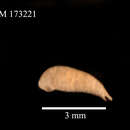en
names in breadcrumbs


“Osicryptus hirsutus n. sp.
Figs. 33A-330
Description. 2.1 mm long, Antenna 1 with nine teeth on inner posterior margin of lamellar basal segment. Antenna 2 extends caudally to about division line between peraeonal segments VI and VII: first article longest of five flagellar articles. All coxal extensions with many teeth on posterior margins. Propodal segments of all peraeopods vary from bulbous propodus on peraeopod I to elongate oval propodus on VII. At least two mostly tnree) scalelike setae on inner margin of propodi of all peraeopods. Inner margin of propodus on peraeopod VII fringed with short setae. Pleopods all biramus; pleopod 1 with four long setae and one shorter one on exopod, and five long setae on endopod. Pleotelson with simple produced posterior margin. Uropod short; exopod about two-thirds as long as endopod. Exopod tipped with two setae, and endopod with four setae. The species name hirsutus, from the Latin, refers to the haired apical segment of antenna 1.
Type locality. 10-793: 64°11'S, 82°46'W; 64°22'S, 82°27'W; 3294 m. Holotype and two paratypes.
Distribution and size. 10-773 (1.5 mm); 10-782 (1.8 and 2.2 mm); 10-793 (1.5, 2.1, and 2.1 mm); 10-852 (2.0 and 2.4 mm); 11-895 (2, each 1.2 mm); 11-904 (2.7 mm).
Affinities. The species is very much like Cryptoniscid 1 [Sars, 1899] of uncertain status, but the peraeopods are quite different in the two species.”
(Schultz, George, 1977: 117)